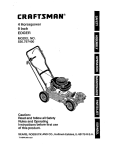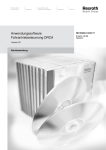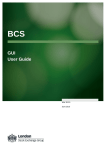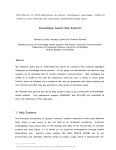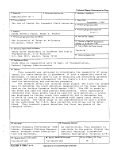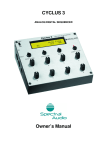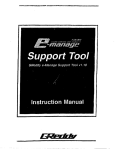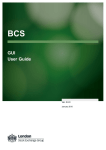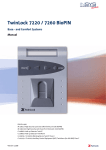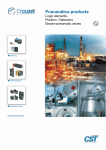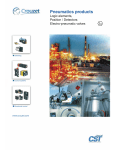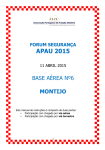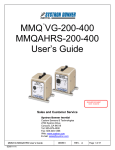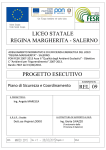Download Systron Donner -- TL8
Transcript
INSTRUCTION MANUAL ON STABILIZED TRIPLE POWER SUPPLY TLS-3 SERIES SVSTRON DONNER G M B H INSTRUCTION MANUAL .... ,,,.. tl ......······:.f ············ ............ ···::···~:···~~···::: ••',,•!~.;..·• ...••'ee•!!!.ttt'! ...... ~dlf·' ,.,~~~.•.••••tr,,er,,.,.... ~.~..~............ !dt• ....... ~.,!i"'r . ., AC MODEL TL8-3 EG and TL8-3 EG OV STABILIZED TRIPLE POWER SUPPLY Note : In case of technical questions or spare part requests please specify the model and serial-No. of the power supply. Address: SYSTRON DONNER GMBH, 8 Munchen 60, BodenseestraBe 113 Telephone: (0811) 87110 21 WARRANTY. SYSTRON-DONNER instruments are warranted during a period of one year from date of shipment to the original purchaser to be free from defects in material and workmanship. This warranty does not apply to vacuum tubes, except as they are warranted by the tube manufacturer. The liability of SYSTRON-DONNER under this warranty is limited to replacing or repairing any instrument or component thereof which is returned by the buyer, at his expense during the one year period and which has not been subjected to mis-use, neglect, improper installations, repair, alteration or accident. SYSTRON-DONNER shall have the right of final determination as to the existance and cause of the defect. In no event shall SYSTRONDONNER be liable for collateral or consequential damages. This warranty is in lieu of any other warranty, express, implied or statutory, and no agreement extending or modifying it will be binding upon SYSTRON-DONNER unless it is made in writing and signed by a duly authorised officer of the company. RECEIVING INSPECTION. Every SYSTRON-DONNER instrument is carefully inspected and is in perfect working order at the time of shipment. Each instrument should be checked as soon as it is received. If the unit is damaged in any way or fails to operate, a claim should immediately be filed with the transportation company. REPAIRS. Whenever a SYSTRON-DONNER instrument requires service, the nearest SYSTRON-DONNER representative should be contacted . All representatives will provide immediate service or arrange the return of the instrument to the factory if necessary. Please specify both model and serial number in all correspondence concerning claims for warranty repair. Address all enquiries to SYSTRON-DONNER GMBH., 8 MONCHEN 60, BODENSEESTRASSE 113, Telephone: (0811) 871 10 21. ii TL 8-3/2-73 TABLE OF CONTENTS . SECTION 1 2 3 4 5 PAGE DESCRIPTION 1.1 Introduction ...... .............. .... .... . 1.2 General Features .. .. . ... . . . . . . .. . .... ... . 1. 3 Precautionary Measures .. . .. . . . .. . .. . .. . . . 1.4 Specification Data Sheet . .... .. .. . ...... . 1-1 1-1 1-2 1-3 OPERATION 2.1 Electrical Connections ...... . ........... . 2.2 Controls .. . . .. ............ .. . ... . . . ..... . 2. 3 Operation .. . ...... .. .......... . ... . .. ... . 2-1 2-1 THEORY 3. 1 3.2 3.3 OF OPERATION Genera 1 . .... .............. .. . . ... . . . ... . . Optional Features .. ...... .. .... ........ .. Block Dfagram . . . . . . .... . .... ......... .. . . 3-1 3-2 3-3 MAINTENANCE 4. 1 Genera 1 . . .•.•• . •• •...• . . • . . •.•..•...•.•.• 4.2 loads and Interconnections ......... . .... . 4.3 Troubleshooting .. . ..... . ... . . . ... . . .... . . 4-1 4-1 4- 1 CALIBRATION 5. 1 Genera 1 •..• .• .• • . ••..•• . ••.. ..•.•... . .••. 5.2 Test Equipment Required . ..... ... . ... . .. . . Calibration Procedure . . . .. . ............. . 5.3 5-1 5-1 5-1 2-2 APPENDICES Troubleshooting Guide . . . . ....... ... . .. Component Part Plan 0001/ 2 . .......... . Component Part Plan 0002/ 3 . . . . ...... . . Schematic Diagram . . ........... . ...... . TL 8-3/2-73 A-1 t o A-5 ;i i MEASUREMENT OF REGULATION AND RIPPLE The specifications cited herein for regulation and ripple can be readily attained on every SYSTRON-DONNER power supply, provided the proper method of measurement is employed. The major consideration is that the highly stable meter and oscilloscope, specified in the calibration section test procedures, must be connected to the sensing terminals and not the load terminals . The reason for this precaution i s that the voltage drop between the load terminals and sensing terminals will yield an inacurate regulation ripple measurement. i iii TL 8-3/2-73 SECTION 1 DESCRIPTION 1.1 INTRODUCTION The TL 8-3 Triple Output Lab Series power supplies are flexible and dependable sources of D.C. power, which can be used to meet a variety of needs. These needs may range in scope from inspection and production testing, to laboratory bench testing and systems applications. The wide range of outputs availabl e makes these units well suited for use as basic laboratory power sources. The ability to provide power packaged in minimum space with high reliability meets the demands of most systems and laboratory requirements. All components used in the construction of the Medium Power Half Rack units are of the highest quality available, and have been subjected to 100% incoming inspection. Each electrolytic filter capacitor is of computer grade, and has been quoted by the manufacturer as having a life expectancy exceeding ten (10) years. All silicon transistors have been 11 derated 11 and temperature aged to provide high reliability. All rectifiers are hermetically sealed silicon units, and all zener diodes have been temperature stabilized. 1.2 GENERAL FEATURES Independent metering for each output allows simultaneous monitoring of voltages and current. A front panel lamp indicates an overload condition on any of the three outputs. Coarse and fine output controls for each output permit precise adjustability. Constant Voltage Mode A constant voltage is maintained across the output terminals at any preset value from zero to rated voltage output, provided that the load does not draw more than the rated output current. Automatic Current Limiting Short circuit protection is provided by the Automatic Current Limiting circuit which limits the maximum output current under al l load conditions. The point at which automatic current limiting occurs is at approximately 110% of the maximum rated current output of the unit. In the event of a short circuit, the output voltage will drop to zero, and will return to its previous level only upon removal of the short ci rcuit. TL 8-3/2-73 1-1 Automatic Overvoltage Protection (Optional Feature, "A" output only) Automatic Overvoltage (OV) protection prevents the output voltage from exceeding the programmed voltage and can be internally adjusted through an access slot in the cover. 1.3 PRECAUTIONARY MEASURES Wire Size To assure proper regulation under all load conditions, and to prevent severe distortions of the AC line voltage, it is very important to take into consideration the physical size and current handling capabilities of the input power line. Serious losses in regulation and an increase in ripple may result from underrated or overloaded AC input lines. The maximum AC impedance from the breaker box to the power supply input should not exceed 0.75 ohms. Voltage Regulator and Inverter Inputs Do not use voltage regulators or inverters as a primary power source. The outputs of these devices are usual ly not sinusoidal in nature, and if used as the AC source for the power supply, may cause serious loss of regulation of the power supply output. Capacitive input filtering used for semiconductor power supplies requires charging to the peak of the rectified AC wave which non-sinusoidal AC sources may not provide. Systems Considerations In systems applications it is recommended that each power supply input power line be run separately to the AC distribution box, in order to m1n1m1ze cross coupling and interaction between equipment . To keep the AC ripple in the output to a minimum , it is recommended that the AC input cables should not be run in close proximity to the output load cables. 1-2 TL 8-3/2-73 . SV~TADN ~DONNER TL8-3 TRIPLE OUTPUT LAB SERIES FEATURES e e e e e THREE OUTPUTS - INDEPENDENTLY ADJUSTABLE AUTOMATIC ELECTRONIC CURRENT LI MITING NO TURN ON /TURN OFF TRANSIENTS THREE INDEPENDENT DUAL RANGE METERS OVERVOLTAGE PROTECTION OPTION ELECTRICAL SPECIFICATIONS Input: 220 VAC ± 10%; 4 7-65 Hz Output:<1> Triple Floating; isolated from ground, 300 VDC max. A) 0 to + 8 VDC, 3 ampere; rating reduces to 2 ampere at 0 VDC. B) 0 to + 32 VDC, 1 ampere; rating reduces to 0.5 ampere at OVDC. C) 0 to - 32 VDC at 1 ampere; rating reduces to 0.5 ampere at OVDC. All outputs are referenced to a common return electrically isolated from chassis ground. Regulation, Line: 0.02% or 2 mV*, for 200-240VAC line change, at any output within specifications. Regulation, Load: 0.02% or 5 mV*, no load to full load, at any output within specifications. Ripple: 500 pV RMS ; 3 mV p-p. (10 MHz) Stability: 0.05% or 10 mV*, for 8 hours after warm-up. Measured at constant line voltage, load and ambient temperature. Temperature Coefficient: (0.02% + 400 ,uVWC Temperature Range : 0 to + 40 °C. · Recovery Time : 50 microseconds to within 0.05% or 15 mV* of output voltage, for 80% step change in rated load (.21oad to full load) Short Circuit Protection: Automatic Electronic Current Limiting. AC Power Input Protection: Fuse. Voltage Adjustment Range: Continously adjustable vernier controls. oc *Whichever is greater. (1) At maximum line voltage condition, the total output current should not exceed 80% of total allowable current. SVSTRCN rlf£?.:) G M B H CONNER Output Model TL8-3EG Volts Amps Impedance* DC-1 KHz 0 to +8VDC 0 to +32 VDC Oto -32VDC 0-3 0-1 0-1 0.003 0.010 0.010 • Nominal GENERAL AND PHYSICAL SPECIRCATIONS Operation Mode: Constant voltage with automatic current limiting. Controls: Voltage: Coarse and Fine ; 0 to rated output; front panel. Reso- lution 1 mV on fine control. Input Power: Front panel switch and indicator, AC ON. Metering: (3) Combination Volt/Ammeters with front panel selector switch. Terminals: Front Panel: Positive output A, Positive output B, Negative output C, common return, chassis ground. Overvoltage Protection: Internal adjustable overvoltage protection is available, as a factory option on output A (0 to + 8 VDC) Size: 77/a" W x 47/a" H x 12e/1e" D Weight: 16 lbs. 8 Mi.inchen 60, BodenseestraBe 113 Telefon 87110 21 Telex 5-29615 Block Diagram Series Pas s Amplifier DifferentialAmplifier Option : OV- Protection + ~-----4---4--~--4---------------------------------~------~o Common DifferentialTherma l Fuse Line- Fuse -Refere ces f-:.----~~--------------(0 AC -Line Current- Sensing - C - Output •11-l--~@ GND 13'' -, I t- ) _j cl 1 AC LINE CORD 7 FEET LONG WITH 3 PRONG MOLDED MALE PLUG OPTIONALOVS MODULES / (4) RUBBER FEff (REMOVABLE) U0-32 THREAD':D MOUNTING) \: v 2 3/8'' \_ ~ 9 l/2" Description The TLB-3 Triple Output Lab power supply is a multiple output unit specifically designed for laboratory applications utilizing IC circuitry . Independent output voltages are provided to allow simultaneous power to be supplied to a typical IC (digital or analog) breadbord circuit, as well as simultaneously , two additional independent power sources fo r typical au xiliary circuitry . Output voltage and currents may be independentl y monitored A variety of voltage and current outputs are available prov iding unexcelled operational versatility and flexibility . Th is output flexibility permits the user to have complete convenience in filling laboratory power requirements . The Triple Lab Power Supply utilizes silicon semiconductors permitting operation at its maximum temperature rating without derating. SECTION 2 OPERATION 2.1. ELECTRICAL CONNECTIONS Input, Power A heavy duty 3 wire line cord and molded plug with grounding prong provides a path for input power to the unit. The power handling ability of the AC power lines feeding AC power to the li~e cord must be considered, as serious losses in regulation and substantial increases in ripple can occur as a result of insufficient power handling capacity of these lines. The AC impedance from the breaker box to the power supply input connector should not exceed 0.75 ohms. All AC power line connections must be securely tightened, and any movable electric contact surface (such as the wiper arm of a variable transformer) should be kept clear of impedance producing oxide coatings. Care should be exercised in selecting the proper wire size for the AC input lines. The figures listed in Table 2-1 will serve as a guide in making this selection. TABLE 2-1 Length of Run (Single Lead) 10 10 20 50 feet feet feet feet or less to 20 feet to 50 feet to 100 feet AC INPUT WIRE SIZE Wire Size (AWG Standards) 12 10 8 6 Output, Front Panel Five bindung post terminals mounted on the front panel provide output and ground connections. TL 8-3/2-7 3 2-1 CONTROLS 2.2 Front Panel FRONT PANEL CONTROLS Name Function AC POWER VOLTAGE ADJUST (Coarse) VOLTAGE ADJUST (Fine) METER SELECT ( V, I ) Toggle switch, controls input power Potentiometer, adjusts voltage output Potentiometer, adjusts voltage output Rotary switch, controls function of ( 2 pos.) output meters Internal All internal control settings have been factory preset, and require no additional adjusting. However, if it should become necessary to adjust any of the internal controls due to circuit changes caused by component aging or replacement, refer to the calibration section of this instruction manual . 2.3 OPERATION Control Settings Set all coarse and fine output controls fully CCW and set the meter select switch to V. Grounding Either side of either output may be grounded or the outputs may be used in a floating condition. Power On Connect the power supply to a nominal AC power source. Set power switch SlOl to AC-ON, and observe that pilot lamp DSlOl glows . Warm-up No warm-up time is necessary to place the unit into operation. However, a 30 minute warm-up period is recommended to reach rated stability. 2-2 TL 8- 3/2- 73 SECTION 3 THEORY OF OPERATION 3.1. GENERAL The purpose supplies is to transform stable and adjustable DC major circuits. As each to the schematic diagram of the TL 8-3 Triple Output Lab Series power and rectify the AC input a well regulated, output. The following paragraphs describe the circuit is described, reference should be made in the rear of this manual. Primary Input Input power is obtained through transformer TlOl full wave rectifier diode sets (CRl, CRlO), (CR2, CRll), (CR19, CR20) and filter capacitors C3, ClO and Cl7 . When AC power switch SlOl is set to AC-ON, AC pilot lamp DSlOl glows, and AC pqwer is applied to TlOl. Regulated DC output power is immediate·ly available . Reference Supplies The C3 voltage appears across the +12V and (+lOV, +6.2V) reference supplies~ These reference voltages are, in turn, developed across CR25, CR5 and CR6, respectively. The ClO voltage appears across the -12V and (-lOV, -6.2V) reference supplies . These reference voltages are, in turn, developed across CR26, CR14 and CR15, respectively. Series Regulator The rectified and filtered voltages from the three input rectifier sections are directed through each of the respective series pass transistors. The conduction of each of these transistors is controlled by independent circuitry which causes them to act as variable resistors. Their overall resistance varies in accordance with the need of the power supply to increase or decrease the output voltage . Each pass transistor is controlled by a driver transistor which is, in turn, controlled by the corresponding voltage (error) amplifier. Voltage (error) Amplifier The theory of operation for all three voltage amplifiers is identical. A sample of the output voltage is compared with a stable reference (see Reference Supplies) at the base of the input stage of the amplifier. An unbalance caused by a voltage change at either the output terminals or across the output control pots will appear as a voltage change at the collector of the first stage. For example, an TL 8-3/2-73 3-1 increase in output causes the first stage to turn off, turning on the second transistor, turning off the third transistor and turning off the driver transistor. This causes the pass to be turned off and the output voltage to decrease. Current Limit Circuit In the case of all three current limit circuits, a voltage drop is sensed across a small resistance in series with each output. As current increases, this voltage drop increases, eventually turning on a transistor in its current limit circuit which turns off the first stage of the voltage amplifier for this output. This has the overall effect of independently shutting down this output. 3.2 OPTIONAL FEATURES Overvoltage (OV) Protection If the output voltage should use above the threshold set by the OV pot, the OV sensing transistor will turnon, turning on the SCR driver. This applies a signal to the gate of the SCR causing it to "fire" and place a "crowbar" across the output. This short circuits the output and activates the current limit circuit which turns off the pass transistor. 3-2 TL 8-3/2-73 (..) I (..) (..) I ""'-~ 1\) ........ (..) I (X) r -l Gl Line - Fuse AC ·Li ne ~ ThermalFuse rmnstormo: 'Switch + 1 . . 6l T v I I I <] . 1-D-1 Current-Sensing J *· -Refere~ces t - +Refer epees 1 I 1 Series Pass T I 7'\ I \l Amplit~ 1 f. Current - Sensing 1-D-1 l <] Differential Amplifier Amplifier t •II 1 I V- Adjust V-Adjust • t t V-Adjust 11 1: ::!r- DifferentialAmplifier I r---1-JAA:m~p:h~fl:e~rJI=======f:--~• l~ ' _,... 1 ® 1Oif..f_e_r_e-n_ - t-:-ia--;1 L....J1 Current- Limitindicator 6 t Series Pass Amplifier T 1-Q-I 'l.,1 I Current -Sensing Series Pass common (c)) GND (2)- C- Output (oJ ~ +8-0utput Option: OV- Protection (O)+A-Output G> m w' (X) r -f 0 3 ..... 0 .... (C 0 0 A' 0 0 CD - SECTION 4 MAINTENANCE ---- - ---------- - ---- - ---~---------- - WA R N I N G High Voltages Are Present Use Caution GENERAL 4. 1. This power supply is a prec1s1on ins t rument . I t is strongly recommended that only experienced troubles hooting personnel perform troubleshooting operations or attempt to repair the unit. If the power supply appears to be malfunctioning at all, the fol l owi ng procedure is recommended for isolating possible defects . 4.2 LOADS AND INTERCONNECTIONS 1. 2. 3. 4.3 Disconnect all interconnections and loads to which t he unit is normally connected. Connect a separate resistive dummy load across each output terminal. This load should be of s ufficie nt value to allow the unit to operate at its maximum rated current and voltage output . Apply nominal AC input power to the unit and check for normal operation . Satisfactory operati on at this time woul d indicate that any malfunction previously encoun t ered, is external in nature. All interconnections and l oads normall y used in conjunction with this power supply should t he n be carefully checked for electrical defects. TROUBLESHOOTING 1. Set VOLTAGE ADJUST and VOLTAGE VERNIER controls f ul ly CW. Using a 20,000 ohms per volt voltmeter or oscil l oscope, check the voltages across the various circuit components listed in the TROUBLESHOOTING GUIDE, located immed i ately before the schematic diagram at the rear of this instructi on manual. The sample voltages listed in th i s guide apply only if the unit is operating at its nomi nal AC input , and has no load on any output unless otherwise specified . Any reading which is grossly incorrect indicates that the stage being tested or the one immediately preceding it , i s defective. The Schematic Diagram and appropriate sections of the Theory TL 8- 3/2-73 4-1 of Operation will prove helpful in any troubleshooting work. Proper polarity to be observed when testing can be easily obtained from the Schematic Diagram. 2. 3. 4-2 If voltage checks show no noticeable deviati ons from the prescribed values, disconnect AC power and proceed with point-to-point resistance checks across pots, switches, diodes, resistors, transistors, in that order. When the trouble is of an intermittent nature, such as poor regulation, ripple, etc., the use of an oscilloscope to determine dynamic changes will be necessary. TL 8-3/2-73 SECTION 5 CALIBRATION 5.1 GENERAL The following adjustments should be made when necessary to assure optimum operating characteristics and maximum efficiency of the SYSTRON-DONNER power supply. TEST EQUIPMENT REQUIRED (or equivalent) 5.2 (A) (B) (C) (D) (E) 5.3 Oscilloscope, Tektronix Type 561 Differential Amplifier Plug In, Tektronix Type 63 Time Base Plug In, Tektronix Type 67 Differential VTVM, Fluke Model 825A DC Ammeter, Weston Model 901 CALIBRATION PROCEDURE (A) Maximum Voltage- set front panel V ADJ fully clockwise, and Fi ne fully counter-clockwise for a 11 three outputs. Adjust maximum voltage control R92 (0 to +32V), R93 (0 to -32V), and R94 (0 to +8V) to obtain the maximum rated output voltage for each ~utput. (B) (0 to +8V) Maximum Current - set output voltage equal to 8.00 VAC ± 10 mv. Monitor Vout with a scope (10mv/cm scale). Rotate the current adjust pot (R59) fully clockwise . With an external DC current meter and a variable load adjust the output current to 3.3 Amps. ±100ma. Slowly rotate R59 in the counter-clockwise directi~n until an affect is seen on the output voltage. Check the setti ng by adjusting the variable for max. current. The maximum current the until should be capable of is 3.3 Amps. (c) Meter Circuit - Place the meter select switch in the volts position. Adjust each output to its nominal voltage ±20mv. (Differential VTVM, Fluke Model 825A is recommended). Calibrate each meter by adjusting the pot R26a for +32V -Output; R51a for -32V -Output and R55a for m8V -Output. Place the meter select switch in the Amps position, then l oad down one output at a time . Monitor the output current carefully with an accurate DC current meter. For the 0 to +32V output, adjust R16 so both the A meter and the reference meter indicate the same current. For the 0 to -32V output, calibrate the B meter by adjusting R50. Finally, calibrate the C meter with R54 . 11 11 11 11 11 TL 8-3/2-73 11 11 11 11 11 5-1 TROUBLESHOOTING GUIDE 0 to +32V Output Vin ·~ 220VAC No load on output unless otherwise specified Symptom Zero output voltage Zero or small negative output voltage Possible Problem Area AC Input Section Rectifier Section or -6.2V·and -10V Reference Section Series Pass and Driver Section Voltage Amplifier Circuit Zero or small positive output voltage Current Limit Circuit If the AC power lamp (DS101) is off, one or more of the components listed has probably failed. F101 open circuit; S101 open circuit; S102 open circuit. Measure the voltages across the following components. Check the levels measured with those indicated below. C3.,.~ 26V; CR14F-.'>· lOV; CR15~Y6.2V Measure the voltage drop across the base to emitter junction of QlOl and Q3 (across R9 and R6). Both transistor junctions should be forward biased. The base to emitter voltages of Q20, Q5 and Q6 should be about 0.6 volts DC, in the forward direction for that transistor. If the voltage across R14 is approximately zero, then Q4 should be cutoff and CR7 reversed biased . If the voltage across R14 is significant, then there is current flowing in the supply. The output terminals are probably shorted to common. Check QlOl for collector emitter short Q3 Q20 Q6 05 open Probably Q4 has failed open and/or CR7 has failed open. Measure the voltage across CR26, the level is approximately 12 volts. ~-~- Large and Series Pass and unregulated Driver Section output voltor Voltage Amplifier age Circuit Output does Voltage Amp. Ckt. not current or Current Limit Ckt. 1i mit or -12V Reference Section A-1 II II II II II II II II II II II II II II II II II 11 II TL 8-3/2-73 Symptom Overload lamp does not turn on when current limiting Overload lamp always on TL 8-3/2-73 Possible Problem Area Overload Lamp Logic Circuit Overload Lamp Logic Circuit Check for failure of DS102 overload lamp. With the supply in current limit operation, the base to emitter voltage of Q21 and Ql should be about 0.6 volts in the forward direction. Check Q21 for collector emitter short Ql (Insure that no other output is in current 1i mit) . Check Q24 for collector emit ter short Q23 II II II II II II II II II II A-2 TROUBLESHOOTING GUIDE 0 to -32V Output Symptom Zero or sma 11 positive output voltage Possible Problem Area Rectifier Section or -6 . 2V and -lOV Reference Section Series Pass and Driver Section Voltage Amplifier Circuit Zero or small negative output voltage Large and unregulated output voltage Output does not current limit Overload lamp does not turn on when current limiting A-3 Voltage Amplifier Circuit or Current Limit Circuit Current Limit Circuit Series Pass and Driver Section or Voltage Amplifier Circuit Voltage Amplifier Circuit or Current Limit Circuit or +12V Reference Section Overload Lamp Logic Circuit Measure the voltage across the following components. Check the levels measured with indicated below . C10~26V; CR5~10V; CR6~6.2V Measure the voltage drop across the base to emitter junction of Q102 and Q8 (across R32 and R33). Both transistor junctions should be forward biased . The base to emitter voltages of Q9, Qll and Q12 should be about 0.6 volts DC, in the forward direction for that transistor . If the voltage across R47 is approximately zero, then QlO should be cutoff and CR16 reversed biased. If the voltage across R47 is significant, then there is current flowing in the supply. The output terminals are probably shorted to common. Check Q102 for collector emitter short II Q8 II II II II II Q9 II II II II Q12 II II II II II II Qll II II II open Measure the voltage across CR25, this is approximately 12 volts . Possibly QlO has failed open and/or CR16 has failed open. Check for failure of DS102 overload lamp . With the supply in current limit operation, the base to emitter voltage of Q21 and Q24 should be about 0.6 volts in the forward direction. TL 8-3/ 2-73 TROUBLESHOOTING GUIDE 0 to +8V Output Symptom Possible Problem Area Zero or small negative output voltage Rectifier Section or -6.2V and -lOV Reference Section Measure the voltage across the following components. Check the levels measured with those indicated below (at no load) . Cl7~17.5V, CR14 ;~10V, CR15~6.2V. Series Pass and Driver Section Voltage Amplifier Circuit Zero or small positive output voltage Current Limit Circuit Current Limit Circuit or Overvoltage Circuit Large and unregulated output voltage Overvoltage Circuit And Series pass and Driver Section or Voltage Amplifier Circuit TL 8-3/2-73 Measure the voltage drop across the base to emitter junction of Ql03 and Q13 (across R57 and R56). Both transistor junctions should be forward biased. The base to emitter voltage of Q15, Ql6 and Q17 should be about 0.6 volts DC, in the forward direction for that transistor. If the voltage across R65 and R98 is approximately ze ro , then Q14 and Q23 should be cut-off. The base to emitter junction of Q23 should be reversed biased. If the voltage across R65 and R98 is significant, then there is current flowing in the supply. The output terminals are probably shorted together, possibly by the overvoltage circuit. Set R74 fully CW. The base to emitter voltages of Q18 and Ql9 should be approximately 0.6V forward biased. Ql9 collector should be equal to the observed output. Check Ql03 for collector emitter short Ql3 Q15 Q17 open Ql6 II II II II II II II II II II II II II II II II II II II A-4 I I 0 Symptom Overvoltage triggers, even though output is normal and R74 is set fully CCW Output does not current limit Overload lamp does not light during current limiting Possible Problem Area Overvoltage Circuit or -12V Reference Section Check Ql8 for collector emitter short Ql9 Measure the voltage across CR26; the level should be 12 volts. Current Limit Ckt. or +12V Reference Section or -12V Reference Section Overload lamp logic circuit Q14 failed open or CR23 failed open. Measure the voltage across the following components. Check the levels measured with those indicated below . CR251?'l'l2V; CR26 ~ 12V. II II II II II Check for failure of DS102 (overload lamp). With the supply in current limit operation, the base to emitter voltage of Q21 and Ql should be about 0.6V forward biased. 0 @ J ~l ( c A-5 TL 8-3/2-73
































